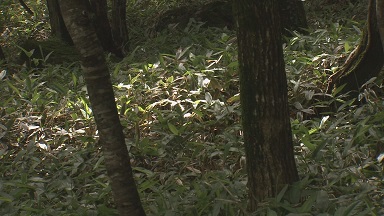
Broadleaf bamboo is spreading like wildfire on Hallasan Mountain. Researchers say it now covers some 21 square kilometers, and they’re still working on the best way to contain it. Minhoe Kim reports.
Report
[slug]
Broadleaf bamboo took over mountain after grazing was banned
Knee-high broadleaf bamboo covers the Eorimok area of Hallasan Mountain.
Years ago, cows and horses used to graze on the plant, but when animal grazing in national parks was banned 30 years ago, the bamboo quickly spread to cover the mountain.
Researchers have now presented figures on just how much of the mountain is covered by this plant for the first time.
Researchers took aerial photos of 21 square kilometers of land 1,400 meters above sea level along the Hallasan Mountain preservation zone.
Analyzing the photos, they found that 88 percent of the land, or 19 square kilometers, has been covered by broadleaf bamboo.
This is equivalent to more than 2,600 soccer fields.
The study also revealed that the growth of the bamboo - which is mostly horizontal - is impeding the growth of other plants.
Interview
Hyeon Jin-o / Head, Northeast Biodiversity Institute
The royal azaleas aren’t doing well. We have proven that the broadleaf bamboo has severely damaged shrubs like the azalea and royal azalea on Hallasan’s slopes.
< 현진오 / 동북아생물다양성연구소장 >
산철쭉도 생육 상태가 아주 불량한 것이 많아서 조릿대에 의해 아고산대 지역 산철쭉이나 털진달래 같은 관목류들이 엄청나게 피해를 받고있다는 것을 실증할 수 있었고요.
Broadleaf bamboo does prevent soil loss, but if the species spreads at its current rate, the whole mountain will soon be covered with the plant - killing plenty of other species as it moves.
[slug]
Animal grazing, trimming are effective
To try and contain the spread of the bamboo, authorities temporarily allowed horses to graze and hired workers to cut the fast-growing plant.
While effective, specialists have pointed out that the animals could cause soil loss and that cutting could affect other plants in a negative way.
Interview
Jeong Se-ho / Jeju World Natural Heritage Center
We will keep studying to determine which method of control is more effective - animal grazing or trimming.
< 정세호 / 세계유산본부 생물자원연구과장 >
말 방목을 했을 때 훼손됐던 토양의 표고 변이를 찾아내서 말 방목이 좋은지, 벌채가 좋은지에 대한 연구에 박차를 가하겠습니다.
[Reporter] Minhoe Kim
[Camera] Kim Yong-min
The province will continue to look at the effectiveness of both grazing and cutting control methods through next year.
Minhoe Kim, KCTV





